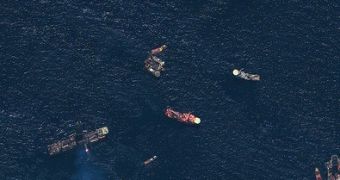Two Russian-built submersibles would be able to stop the oil leak from Deepwater Horizon site in the Gulf of Mexico. Their captain, Yevgenii Chernyaev is positive about it and says that it is not yet too late. The two submersibles that can reach depths of 6,000 meters can succeed in putting a cap over the oil leak, but a certain protocol must be followed. Meanwhile, the Russians started their third season of exploration at the world's deepest lake, Baikal.
The first two Lake Baikal expeditions revealed gas hydrates resources, thought to be a potentially alternative fuel source. These gas hydrates can usually be found at temperatures at or below 0, or deep in the oceans. Due to the lake's depth of 1,637m and its extreme low temperatures, gas hydrates form at 350m below the surface.
Chernyaev's team is very proud of the subs and may easily prepare for a future intervention in the gulf. The captain is convinced that these are probably the only deep-sea vessels able to stop the spill. “Our subs are unique. There are two of them and they can submerge and work simultaneously. Also, they are powerful enough to work with any other additional equipment. There are only four vessels in the world that can go down to 6,000m - the Mirs, French Nautile and Japanese Shinkai. The Mirs are known to be the best, and we have a very experienced team of specialists,” he told BBC News.
In the Gulf of Mexico oil leaks continuously since April, from a damaged well, as BP's drilling platform exploded and sank. The company can now gather 10,000 barrels of oil a day. Despite this, large quantities of oil are still leaking from the ocean's floor, polluting not only waters but beaches too and endangering animal life.
For this collaboration to be successful, BP and the US government need to first ask the Russian government for help. “It should all be decided on the government level. Asking [Anatoly] Sagalevich [of Russia's Shirshov Institute of Oceanology, which owns the subs] to simply bring the Mirs over is nonsense. Even though we're able to go to much greater depths than where the damaged well is located, we wouldn't be able to do much on our own. We need a team of international specialists and we have to know all the details and probably even build a special device to attach to the subs, and all this needs time,” said Mr Chernyaev.
Apparently there is a way, all that BP or the US need now is a will.

 14 DAY TRIAL //
14 DAY TRIAL //